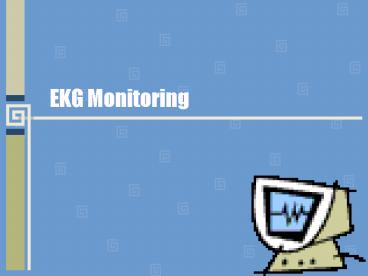EKG Monitoring - PowerPoint PPT Presentation
1 / 23
Title:
EKG Monitoring
Description:
12 Lead EKG. Used to determine both new and old heart problems ... Rate done on EKG by using the 6 second strip from R wave to R wave (normal is 60-100) ... – PowerPoint PPT presentation
Number of Views:525
Avg rating:3.0/5.0
Title: EKG Monitoring
1
EKG Monitoring
2
Types of EKG Monitoring
- Critical Care
- 24 hours/day
- Immediate recognition of problems
- Cardiac stepdown
- 24 hours/day
- Immediate response
- 12 Lead EKG
- When needed
- Specific order or standing order
3
Continuos Monitoring
- 3 to 5 electrodes are placed on chest
- Must change pads prevent irritation according to
policy - Monitor tech watches for changes
- Can determine rate, rhythm and changes
4
12 Lead EKG
- Used to determine both new and old heart problems
- Electricity is conducted differently over injured
heart muscle - Determines rate, rhythm and changes from previous
EKG - Looks at heart in 12 directions
- Usually done by trained personnel
- Current flows from a negative to a positive lead
- The lead placement determines the direction of
the deflection of the QRS complex
5
Lead Placement
6
Interpretation of an EKG
- Graph paper divided into small and large squares
- Each small square represents 0.04 seconds on the
horizontal axis and I mm on the vertical axis - Each large square contains 5 small squares and
represents 0.20 seconds and 5 mm - The electrical activity is recognized by upward
and downward deflections of the wave forms - The baseline is called the isoelectric line
7
EKG Graph
8
Interpretation of an EKG, cont.
- P Wave- represents atrial depolarization and is
the 1st deflection and indicates the results of
the SA node firing - PR interval represents time required for atrial
repolarization and the time it takes for the
impulse to travel from the atria to the
ventricles (normal is 0-.12 to 0.20 seconds) - QRS complex represents ventricular
depolarization (normal is 0.06 to 0.10 seconds) - T Wave represents ventricular repolarization
9
Interpretation of an EKG, cont
- EKG is evaluated for
- Rate done on EKG by using the 6 second strip
from R wave to R wave (normal is 60-100) - Regularity measure for consistency
- P waves look for a P wave before each QRS
complex - PR interval must fall in the normal range
- QRS complexes must be normal or may be problem
in the conduction system - T waves should be rounded, upright and same
shape and size (not inverted )
10
Systematic Review of EKG Strip
- Determine rate and regularity
- Is there a P wave before each QRS complex
- Are P waves rounded and upright
- Measure the QRS and do they look alike
- Look at the T wave. Is it upright or inverted
11
Normal Strip
12
Common Dysrhythmias
- Sinus dysrhythmias
- Sinus tachycardia greater than 100
- Sinus bradycardia less than 60
- Sinus arrest
- Atrial dysrhythmias
- PAC
- SVT
- Atrial fibrillation
- Atrial flutter
13
Common Dysrhythmias, cont.
- Atrioventricular blocks
- 1st degree, 2nd degree, and 3rd degree AV block
- Ventricular dysrhythmias
- V-tache
- V-fib
- PVCs
- Idioventricular
- Ventricular asystole
14
PVC
15
V-Tache
16
SVT
17
Mobitz II
18
Treatment
- Based on severity of the problem
- Lethal dysrhythmias are treated immediately
- Asystole Atropine, Epinephrine
- V-tache lidocaine, Pronestyl, mag sulfate,
amiodarone - V-fib defibrillation with drugs
- Some may cause severe symptoms while others do
not
19
Drug Treatment of Dysrhythmias
- Quinidine
- Pronestyl
- Lidocaine
- Mexitil
- Tonocard
- Tambocor
- Rythmol
- Adenocard
- Magnesium sulfate
- Inderal
- Brevibloc
- Betapace
- Cordarone
- Covert
- Verapamil
- Cardizem
- Lanoxin
- Atropine
20
Pacemakers
- Used to restore regular rhythm and improve
cardiac output - Types
- Temporary
- Permanent
- Transcutaneous
- Transvenous
- Implantable
21
Modes of Delivery
- Single chamber
- Duel chamber
- Fixed rate
- Demand rate
- AV sequential
22
Care of Pacemaker
- Vitals on return from OR
- Check insertion site and provide care as needed
- Monitor for
- rhythm
- pacemaker spike
- PVCs or other abnormal beats
- Usually on bedrest for 24 hours , off the side of
insertion - Gradually increase activities
- Patient must carry ID card
- Instruct patient to take pulse daily
- Notify physician both in hospital and after home
of - Dyspnea
- Syncope
- Dizziness
- Weakness
- Fatigue
- Chest pain
23
Implantable Cardioverter/Defibrillator
- Used to treat life threatening rhythm problems
- Senses heart rate and wave form and delivers a
shock to return heart function to a regular
rhythm - Recognizes V-tach and V-Fib
- If rhythm does not return to NSR, can continue
- Newer models can also recognize tachyarrhythmias
and bradyarrhythmias - Implanted in the sub-q tissue over the pectoralis
muscle - Causes some anxiety to patient when shock
delivered - Family and patient need education and support
- Wears ID bracelet
- Should avoid heavy magnetic fields (MRI, metal
detectors)































